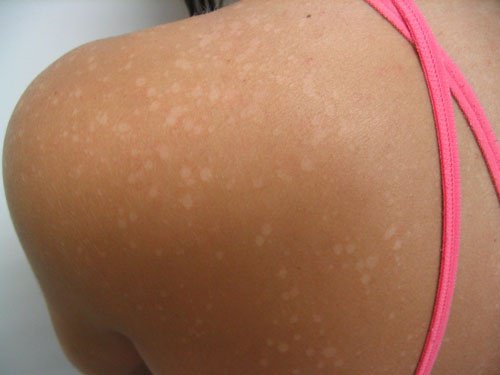White Marks on the Skin: What Causes them?


Written and verified by psychologist Valeria Sabater
White marks on the skin… Do you have them? Have you ever had them? During those summer days, for example, when tanning, it’s common to see some not too pretty white marks appearing on your skin.
What causes them? They even sometimes appear on the back or on the face and on very young people. Where do they come from? What treatment should you follow?
Today we’ll talk about this common reality, mentioning as always that with any doubt or problem, you should also see your doctor, or in this case, your dermatologist.
White marks on the skin: tinea versicolor
Tinea versicolor is very frequent. But don’t worry, it’s not serious and tends to go away. Tinea versicolor tends to manifest itself as white marks on the skin, especially in these areas:
- Chest and back
- Arms and legs
- Areas that are normally out during the summer
They appear especially during the hotter times or right when fall begins. They generally appear on younger people because of sweating, hormonal changes, or humidity.
As we said before, it’s not dangerous, contagious, or painful. It’s only the appearance of these not pretty white marks on the skin, which are resistant, and not easily seen.
Read also:
How to Prevent Excessive Sweating
How is tinea versicolor treated?
Tinea versicolor is a type of fungus, and as such, requires treatment. As we said before, it tends to be effective, so don’t worry. In general, these are the most common treatments:
- Anti-fungal medication like terbinafine or miconazole for example, which are great for treating the infection.
- Another great resource are those called selenium sulphur shampoos. You just apply them to the affected area at night so that they have an effect. Then, you take a good bath in the morning to remove it. It’s that easy.
- If you’d like, a homemade remedy that may be able to help with the marks is aloe vera. Just apply the gel from the plant, do a small massage, and let it work for a couple of hours. Then, take a shower.
- You should keep in mind that if after using these treatments for at least two weeks, you see that the marks are not going away, it’s best to see a dermatologist.
White marks on the skin: vitiligo
Vitiligo is a more serious issue. It’s cause by the loss of melanin. It’s a problem of the immune system causing the body to attack and destroy the melanocytes. Let’s take a look at the more relevant characteristics:
- These white marks on the skin appear anywhere on the body. They can be big or small and come in any shape.
- White marks don’t tend to cause discomfort, pain, itchiness, or irritation. They appear without any symptoms, but they do tend to be noticeable.
- Generally, they are more frequent on people who live in humid areas.
- Sometimes these white marks can turn brown and flake slightly. That’s when they start to become annoying.
Is there treatment for vitiligo?
- Unfortunately, there’s no effective treatment for vitiligo. This autoimmune disease has a genetic component, which makes it hard to stop the destruction of melanocytes effectively and safely.
- Sometimes, re-pigmentation is attempted with the use of steroids or immunomodulators, but it doesn’t always have results. Experts recommend using sunscreens to protect the hypo-pigmented areas from the sun rays.
- In regards to natural remedies, there are a lot of people that resort to aloe vera, turmeric bandages and mustard oil to stop them from happening. Obviously, the white marks on the skin won’t disappear, but you can notice them a little less with consistency. Remember to take care of your skin.
White marks on the skin: nutritional deficit

You should keep this in mind. Sometimes you a poor diet, which is why you suffer from significant shortages in vitamins and minerals.
You have to be especially careful with the smaller ones so that these kind of marks don’t appear. If you see them, it’s worth seeing a doctor so they can perform tests on you. It can be a due to a nutritional deficit:
- Sometimes, white marks on your skin can be due to a shortage in calcium, vitamin D, and vitamin E, which gives way to the appearance of white marks on the skin. Never forget about those calcium rich foods! Remember that dairy products aren’t the only thing rich in this mineral. Vegetables are also abundant in this these essential nutrients for your skin and bone health.
Read also:
- Sometimes, white marks caused by malnutrition are inoffensive, but they could also indicate an imbalanced diet. Always see your doctor for advice.
- Remember that there are a lot of dietary components to improve your skin’s health. On our behalf, we recommend improving your diet; make it complete and balanced to prevent those small problems.
This text is provided for informational purposes only and does not replace consultation with a professional. If in doubt, consult your specialist.








